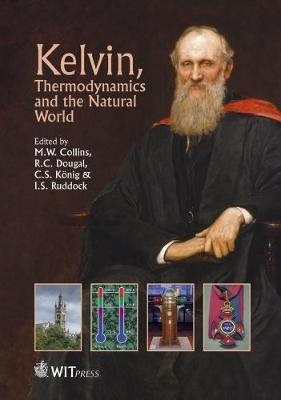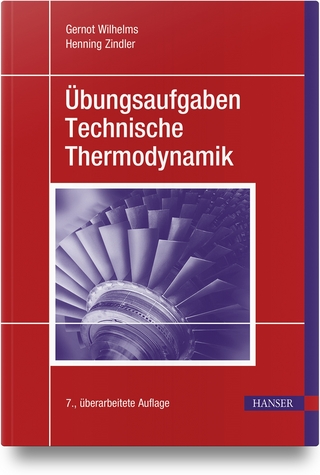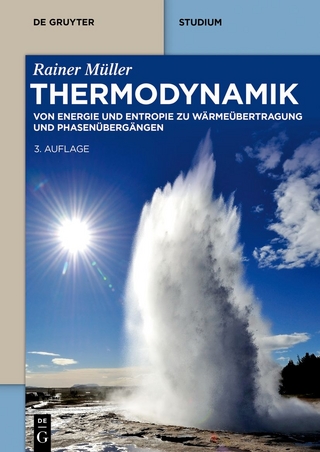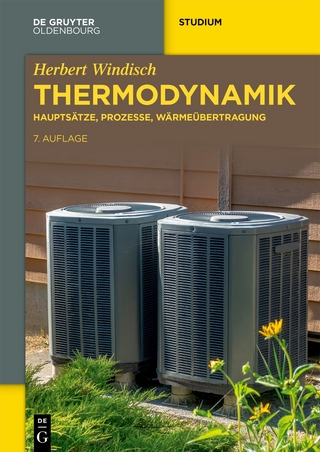
Kelvin, Thermodynamics and the Natural World
WIT Press (Verlag)
978-1-84564-149-8 (ISBN)
This volume looks afresh at the life and works of Lord Kelvin including his standing and relationships with Charles Darwin, T. S Huxley and the X-club, thereby throwing new light on the nineteenth-century conflict between the British energy and biology specialists. It focuses on two principal issues. Firstly, there is the contribution made by Kelvin to the formulation of the Laws of Thermodynamics, both personal and in the content of the scientific communications exchanged with other workers, such as Joule and Clausius. Secondly, there is Kelvin's impact on the wider field of science such as thermoelectricity and geology (determination of the age of the earth). Of late a number of studies and initiatives, including the Centenary celebrations of Kelvin's death and exhibits such as that of the 'Revolutionary Scientist' in the Hunterian Museum, Glasgow, have been undertaken aiding the redefinition of Kelvin's greatness and achievements. The book also raises awareness to 'improve our approach to the teaching of elementary thermodynamics by attempting to empathise with Kelvin's perspective'.It is completed by a full biography, overviews of various monuments to his memory, and short 'Stories in Pictures' on the Atlantic cable, Maxwell's Demon, the universities associated with the development of thermodynamics and the Royal Society of Edinburgh.
Scientists and engineers with an interest in thermodynamics and anyone interested in the work of Lord Kelvin will find benefit in Kelvin, Thermodynamics and the Natural World.
-- Ivan S. Ruddock obtained his BSc and PhD degrees from the Queen's University, Belfast and the University of London (Imperial College) respectively. During his postgraduate research on tuneable mode-locked lasers, he produced the shortest duration light pulses observed at that time. He then joined the academic staff of the University of Strathclyde's Department of Physics in 1977 where he conducted research in a wide range of topics including laser physics, single crystal fibres, nonlinear optics, and optical fibre sensors. After early retirement in 2010 as Reader in Physics, he has maintained links with academia via the co-leadership of HOPE (Horizons of Physics Education), a large academic network funded within the European Commission's Lifelong Learning programme. He is a Fellow of the Institute of Physics and the Higher Education Academy and is active in the public understanding of science through writing and speaking on significant historic personalities such as Lord Kelvin. -- Richard Dougal joined the staff of the Physics Department at Edinburgh University 1964 after having graduated BSc then PhD there. His research continued on topics in atomic and electron physics. A move to applied optics in 1983 coincided with the early years of the rapid growth of work on the properties and applications of liquid crystals. This accompanied the extension of his mainly classical physics teaching interests to supervision of undergraduate projects in optics. There followed an interest in the history of the early work on colour, which he continued after retiring in 2002, as part of the effort of the James Clerk Maxwell Foundation in Edinburgh, where he has been a Trustee since 2000. He is a Fellow of the Institute of Physics. -- Carola S. Koenig is a Research Fellow at the Institute of Environment, Health and Societies and an Associate Lecturer in the College of Engineering, Design and Physical Sciences, both at Brunel University London. She obtained the degree of Dipl-Ing in Mechanical Engineering from the University of Stuttgart, Germany in 1992 and a PhD from Brunel University in 1998. Her expertise is in Computational Fluid Mechanics involving fluid flow with and without heat transfer within a variety of multi-disciplinary environments (e.g. engineering interface with biology, medicine, chemistry, arts). As a Member of the Institution of Mechanical Engineers, she is currently Co-Chair of the Institution's Thermofluids Group and is the Scientific Secretary of the Micro and Nano Flows Conference series. She is also a Fellow of the Institute of the Higher Education Academy. -- Michael W. Collins achieved his undergraduate degree in Engineering Science from St Peters College, Oxford, followed by a PhD and DSc from City University. There, he went through the academic ranks until becoming a Full Professor. In 2005, he joined Brunel University London as a visiting professor in Mechanical Engineering but held previously also visiting professorships at the University of Modena & Reggio Emilia and the University of Ferrara in Italy, at London South Bank University and Fudan University, Shanghai, and the Shanghai University of Science & Technology. Besides being a charted engineer and a charted mathematician he was a fellow of eight professional institutions namely the Institution of Mechanical Engineers, Institution of Engineering & Technology, Institution of Chemical Engineers, the Nuclear Institute, the Institution of Mathematics & Its Applications, but also the Institution of Physics & Engineering in Medicine, the Linnean Society and the Royal Society of Arts. His fellowships reflect the breadth of his interests and subject knowledge spanning from colour and the arts, biofluid and thermofluid mechanics, to history and chaos theory. In 1991, he became an Honorary Fellow of the Italian Union of Thermodynamics, Unione Italiana Termofluidodynamica, and was awarded the prestigious Knights Cross, Order of Merit, for his services to Polish Sciences. In 1992, he was awarded the Busk Prize from the Royal Aeronautical Society.
ContentsForeword by The Rev. Dr James Collins; Preface: In appreciation of Lord Kelvin; Editorial introductionPersonal Chapter 1: Lord Kelvin1 Introduction; 2 The Thomson family; 3 Young William; 4 William Thomson, a Cambridge student; 5 William Thomson, a professor; 6 Academia; 7 The Atlantic telegraph and knighthood; 8 Lalla Rookh; 9 Family life; 10 Glasgow and Cambridge; 11 Netherhall; 12 Navigation; 13 Politics and peerage; 14 Jubilee; 15 Retirement; 16 Industry; 17 Electricity generation; 18 Beliefs and controversies; 19 Health and death; 20 Honours; 21 Patents; 22 Notes; ReferencesChapter 2: Kelvin and his world: a cultural overview1 A complex challenge; 2 An intellectual colossus; 3 Kelvin and the industrial world; 4 The telegraph and Empire; 5 Kelvin's reputation; ReferencesRelationships Chapter 3: James and William Thomson: the creation of thermodynamics1 James Thomson and the Belfast notebooks: the air engine; 2 The Belfast notebooks: lowering of the freezing point of water; 3 The Belfast notebooks: reconciling Carnot and Joule; 4 The denouement; 5 James Thomson and thermodynamics; Acknowledgements; ReferencesChapter 4: James Thomson, an engineer and scientist: the path to thermodynamics1 Introduction; 2 A sketch of the life of James Thomson; 3 James Thomson's achievements in engineering and science; 4 James and William: early dilemmas and discussions; 5 Ideas of heat in the first half of the nineteenth century; the caloric theory; 6 The theory of Sadi Carnot and its reception by the Thomsons; 7 The work of Joule, and the response of James and William Thomson; Acknowledgements; ReferencesChapter 5: Kelvin, Maxwell, Clausius and Tait: the correspondence of James Clerk Maxwell1 Introduction; 2 Saturn's rings and the Adams Prize: Maxwell and Kelvin; 3 Molecular model for a gas: Maxwell and Clausius; 4 Two laws of thermodynamics: Maxwell, Clausius, Kelvin and Tait; 5 Conclusion; Appendix: Transcript of words on postcard of Fig. 1; Bibliography; ReferencesChapter 6: Sir William Thomson, Baron Kelvin of Largs and theInstitution of Engineering and Technology1 Introduction; 2 Lord Kelvin; 3 The institution after Lord Kelvin; Conclusion; ReferencesThe Laws of ThermodynamicsChapter 7: Engineering Thermodynamics and the Carnot Cycle; 1 Introduction: the Carnot Cycle; 2 Timelines of characters; 3 Watt's thermodynamic family tree and place in history; 4 The p-v diagram: James Watt and the Indicator Diagram; 5 The Carnot cycle: Carnot's great achievement; 6 The Carnot cycle: diagrams of Clapeyron and Clausius; 7 The Carnot cycle for a gas; 8 From p-v to T-s: Kelvin's absolute scale of temperature; 9 The 'representational' approach of J Willard Gibbs and the T-s diagram; 10 The Carnot cycle for steam; 11 The reversed Carnot cycle: refrigerators and heat pumps; 12 Contributions to the Second Law of Thermodynamics: Carnot, Kelvin and Clausius; 13 The perfect heat engine: is thermodynamics Platonic in character?; 14 Conclusion; Acknowledgements; ReferencesChapter 8a: The first law of thermodynamics: Kelvin's relationshipwith Joule1 Introduction; 2 William Thomson's fascination with Carnot's theory of heat; 3 Enter James Prescott Joule; 4 Rudolf Clausius finds the solution; 5 William Thomson's answer; 6 Concluding remarks; ReferencesChapter 8b: The first law of thermodynamics: The Joule-Mayer Controversy1 Introduction; 2 Joule, Mayer and the First Law: their peer assessment problems; 3 Joule, Mayer and the First Law: the X-club controversy; 4 Conclusion: honour satisfied; ReferencesChapter 9: The emergence and evolution of the Second Law of Thermodynamics1 Introduction; 2 Heat and temperature: conceptualised and applied; 3 Towards the laws of thermodynamics; 4 The Second Law of Thermodynamics; 5 Thermodynamic properties and processes; 6 Statistical thermodynamics; 7 Later developments: Keenan; 8 Myron Tribus's thermodynamics: an alternative understanding; 9 Conclusions; ReferencesChapter 10: The teaching of thermodynamics today1 Introduction; 2 The technological context of Thomson's 1851 paper; 3The 'scientific' context of Thomson's 1851 paper; 4 Enter Thomson; 5 Death of the Caloric; 6 The second law of thermodynamics; 7 Flawed lawmaking; 8 Returning to Thomson's formulation; ReferencesChapter 11: Entropy as thermal charge: an application of bondgraphs inspired by Carnot and his cycle1 Sadi Carnot; 2 Bond graphs; 3 Systemics; 4 Icons for thermofluid machines; 5 The Carnot cycle; ReferencesChapter 12: Thermodynamic entropy and temperature rigorously defined without heuristic use of the concepts of heat and empirical temperature1 Introduction; 2 Aims and structure of the present treatment; 3 Basic definitions; 4 Definition of energy for a closed system; 5 Definition of thermodynamic entropy for a closed system; 6 Fundamental relation, temperature, and Gibbs relation (for a closed system); 7 Proofs of Clausius and Caratheodory statements of the Second Law and of the Zeroth Law; 8 Conclusions; ReferencesThermodynamics in the wider context of science Chapter 13: William Thomson (Lord Kelvin) and thermoelectricity1 Introduction; 2 On the events that preceded Thomson's discoveries in thermoelectricity; 3 Fundamental thermoelectric Thomson relations; 4 Experimental verification of Thomson thermoelectric effect; 5 On the effect of thermodynamic reversibility on Thomson relation; 6 Generalization of Thomson relations pursuant to thermodynamics of irreversible processes; 7 First Thomson relation novel form; 8 On practical applications of Thomson relations; 9 Thomson transversal EMF: anisotropic thermoelements; ReferencesChapter 14: Kelvin and the age of the earth1 Early estimates; 2 The development of uniformitarianism; 3 Lord Kelvin; 4 Geological time; 5 Growing opposition; 6 Radioactivity as an additional source of heat; Conclusions; ReferencesPostscriptChapter 15: Kelvin in the twenty-first century1 'The Kelvin Problem': space-filling foam; 2 Kelvin Waves and the El Nino effect; 3 The Stirling engine; 4 The Stirling engine in outer space; 5 Atmospheric electricity; 6 From the nineteenth to the twenty-first century; ReferencesConclusion Chapter 16: Honoured by banknotes1 Introduction: the UK, its political history and its banknotes; 2 Kelvin and the University of Glasgow; 3 Queen's University of Belfast; 4 Kelvin and the Giant's Causeway Tramway; 5 King's College, Aberdeen (University of Aberdeen); 6 Boulton and Watt; 7 Conclusion; ReferencesAppendicesThomson, Brunel and the Atlantic cables of 1865 and 1866; The Model Stirling Engine; Maxwell's Demon; Universities of the Heat Engine; Honoured by monuments; Lord Kelvin and the Royal Society of Edinburgh
| Erscheint lt. Verlag | 14.12.2015 |
|---|---|
| Reihe/Serie | Design and Nature ; 10 |
| Verlagsort | Southampton |
| Sprache | englisch |
| Maße | 170 x 244 mm |
| Themenwelt | Naturwissenschaften ► Physik / Astronomie ► Thermodynamik |
| Technik ► Maschinenbau | |
| ISBN-10 | 1-84564-149-3 / 1845641493 |
| ISBN-13 | 978-1-84564-149-8 / 9781845641498 |
| Zustand | Neuware |
| Informationen gemäß Produktsicherheitsverordnung (GPSR) | |
| Haben Sie eine Frage zum Produkt? |
aus dem Bereich


